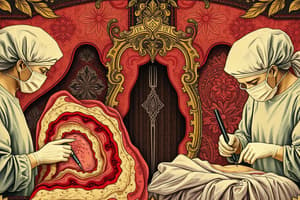Podcast
Questions and Answers
What are the primary materials required for isolating a pure culture from a clinical swab sample?
What are the primary materials required for isolating a pure culture from a clinical swab sample?
Blood agar plates, MacConkey agar plates, an inoculation loop, and an incubator are the primary materials required.
Describe the initial streaking process used to isolate a pure culture on the agar plates.
Describe the initial streaking process used to isolate a pure culture on the agar plates.
The initial streaking process involves taking a drop of the clinical sample and streaking it in a straight line across the surface of the agar, creating parallel lines while sterilizing the loop between streaks.
What is the importance of inverting the Petri dish during incubation?
What is the importance of inverting the Petri dish during incubation?
Inverting the Petri dish prevents condensation from dripping onto the agar surface, which can interfere with colony development.
What conditions should the incubator be set to during the isolation of pure culture?
What conditions should the incubator be set to during the isolation of pure culture?
Why is it necessary to label the Petri dish with specific details before placing it in the incubator?
Why is it necessary to label the Petri dish with specific details before placing it in the incubator?
A 32 years old female patient was admitted for ______ after observing inflammation around the wound site.
A 32 years old female patient was admitted for ______ after observing inflammation around the wound site.
The methods began by streaking the clinical sample across the surface of the ______ agar plates.
The methods began by streaking the clinical sample across the surface of the ______ agar plates.
After streaking the agar, it is important to ______ the lid of the Petri dish immediately.
After streaking the agar, it is important to ______ the lid of the Petri dish immediately.
Sterilizing the inoculation loop is done by passing it through a ______.
Sterilizing the inoculation loop is done by passing it through a ______.
The Petri dish should be placed in an inverted position in the incubator at ______ degrees Celsius.
The Petri dish should be placed in an inverted position in the incubator at ______ degrees Celsius.
To ensure proper identification, the Petri dish must be ______ with the culture reference, name, and date.
To ensure proper identification, the Petri dish must be ______ with the culture reference, name, and date.
After streaking for the first area, one should repeat the process for the ______ areas until completion.
After streaking for the first area, one should repeat the process for the ______ areas until completion.
The final streaking process involves a single ______ streak across the middle of the agar.
The final streaking process involves a single ______ streak across the middle of the agar.
The initial clinical sample for testing came from a ______ sample.
The initial clinical sample for testing came from a ______ sample.
Flashcards
Pure Culture Isolation
Pure Culture Isolation
Obtaining a single type of microorganism from a mixed sample.
Streaking Method
Streaking Method
A technique to isolate bacteria by sequential spreading on agar plates.
Blood Agar Plate
Blood Agar Plate
Used to grow various organisms, including some that require additional nutrients.
MacConkey Agar
MacConkey Agar
Signup and view all the flashcards
Incubation
Incubation
Signup and view all the flashcards
What's the initial goal of the lab test?
What's the initial goal of the lab test?
Signup and view all the flashcards
Why blood agar plate?
Why blood agar plate?
Signup and view all the flashcards
What is the purpose of MacConkey agar?
What is the purpose of MacConkey agar?
Signup and view all the flashcards
What is streaking?
What is streaking?
Signup and view all the flashcards
First streaking area (Q1)
First streaking area (Q1)
Signup and view all the flashcards
What's the purpose of sterilizing the loop?
What's the purpose of sterilizing the loop?
Signup and view all the flashcards
Second, third and fourth streaking area (Q2, Q3, Q4)
Second, third and fourth streaking area (Q2, Q3, Q4)
Signup and view all the flashcards
Why is the plate incubated?
Why is the plate incubated?
Signup and view all the flashcards
Why seal and label plates?
Why seal and label plates?
Signup and view all the flashcards
Study Notes
Patient Case Study - Surgical Wound Infection
- Patient: 32-year-old female
- Hospital: Prince Mohammed Bin Nasser hospital
- Reason for admission: Surgery
- Post-operative complication: Wound infection with pus formation
- Diagnosis process: Pus sample collected, sent to the lab for culture
Microbiology Lab Procedure - Wound Culture
- Goal: Isolate and identify the causative bacteria
- Materials:
- Equipment: Safety cabinet, Bunsen burner, inoculation loop, incubator
- Materials: Blood agar plates, MacConkey agar plates
- Specimen: Pus sample swab
- Procedure:
- Pure Culture Isolation:
- Streak the swab sample across multiple lines on agar plates (4 quadrants).
- Sterilize the loop between each quadrant.
- Label plates with culture details (reference, name, date, sample, and incubation conditions).
- Incubate at 37°C for 24-48 hours.
- Pure Culture Isolation:
Studying That Suits You
Use AI to generate personalized quizzes and flashcards to suit your learning preferences.




